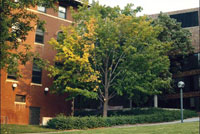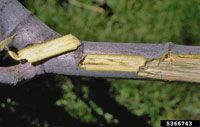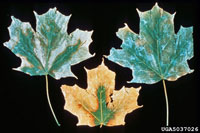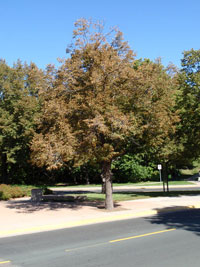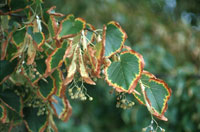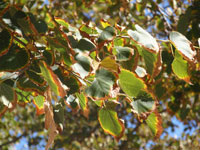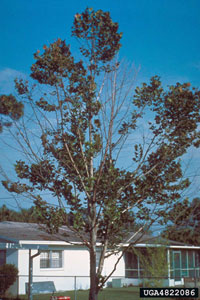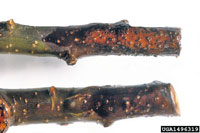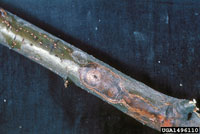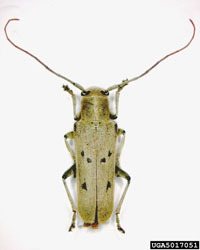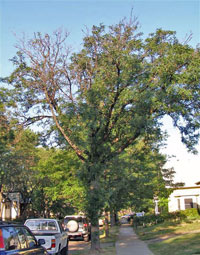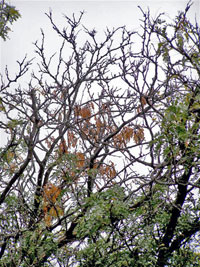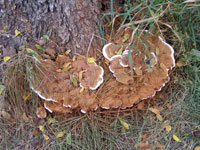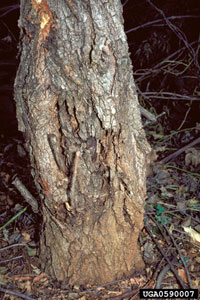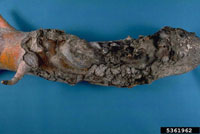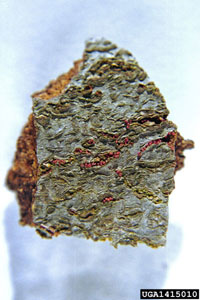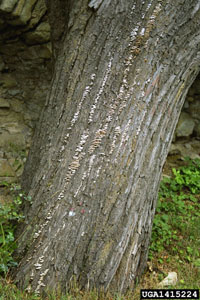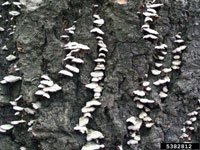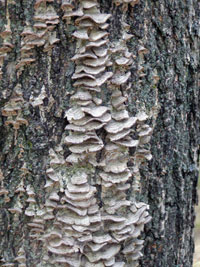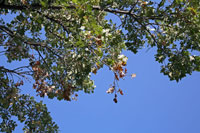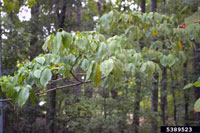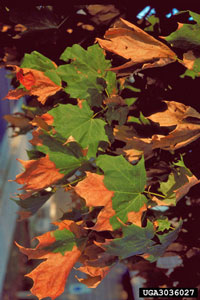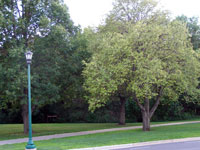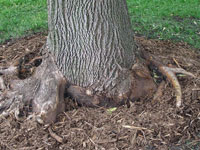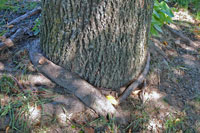Extension > Garden > Diagnose a problem > What's wrong with my plant? > Deciduous > Basswood/Linden > Dead branches in canopy
Basswood/Linden > Trunk/Branches > Dead branches in canopy
1 of 9
Verticillium wilt
Verticillium dahliae
- Leaves turn brown from the edges and tips, wilt and die in severe infections
- Leaves are small and yellowed in chronic infections
- Leaf symptoms are often seen on only one or a few random branches in the canopy
- Brown streaks often can be seen in the sapwood if the bark is peeled back, appearing as rings or arcs in a cross cut
- Symptoms may develop over a single growing season, or over several years
- More information on Verticillium wilt
2 of 9
Deicing salt injury
- Run-off salt kills roots which results in die-back of most branches
- Soil salt damage causes leaf edges or margins to appear burnt or scorched progressing toward the mid-vein
- Affected trees leaf out later than other non-infected trees
- Damage most noticeable in spring
- More information on Deicing salts
3 of 9
Branch cankers
Botryosphaeria obtusa and other fungi
- Random dead branches seen throughout canopy
- Leaves on random branches wilt, turn yellow then brown during the growing season
- Infected branches don’t leaf out in spring
- Cankers are brown to black sunken areas on branch that may have cracked bark and discolored sapwood
- Common on trees stressed by drought, winter injury, wounds, insect feeding or other factors
- More information on canker
4 of 9
Linden borer
Saperda vestita
- Lower branches, lower trunk and surface roots are attacked resulting in limbs in canopy dying; eventually the entire tree is killed after high infestation
- Thinning of the canopy
- Round exit holes ¼ inch wide in trunk
- Adults up to ¾ to 7/8 inch long, longhorns, black body covered by dense olive-yellow hairs; larvae are legless, cylindrical and 7/8 to 1 inch long
- Littleleaf lindens are preferred hosts
- More information on Linden borer
5 of 9
Ganoderma root and butt rot
Ganoderma spp.
- Canopy appears thin with few leaves and multiple dead branches
- Leaves are smaller in size and turn yellow earlier than normal
- Fungal conks, a semicircle shelf fungi, can be found from the base of the tree up to 3 feet high on the trunk
- Conks are reddish brown and shiny on top, white and porous underneath, a rim of white may be visible on the edge of growing conks
- Infected wood at the base of the tree is white, soft, stringy or spongy
- Infected trees frequently break or fall over in storms
- More information on Ganoderma root and butt rot
6 of 9
Perennial nectria canker
Neonectria galligena
- Dead branches and twigs killed by girdling cankers
- Sunken dark brown cankers on main trunk or branches
- Cankers become crater like cavities with age
- Red to reddish orange raised cushion like bumps can occasionally be seen on the edge of the canker
- More information on Perennial nectria canker
7 of 9
Sapwood rot
Schizophyllum commune and Cerrena unicolor
- Dead branches within the canopy
- Groups or rows of small (<2 inches wide) semi-circle self fungi along killed branches or on the main trunk
- Schizophyllum shelf fungi are white and appear fuzzy on top
- Cerrena shelf fungi are white to greenish grey and have concentric rings on the surface
- Common on trees with an open wound or crack
- Wood below fungal shelves is yellowish to white, crumbly and decayed; bark around fungal shelves is killed and often falls off
8 of 9
Drought stress
- Dead branches in the canopy
- Leaves wilt and turn brown at the tips and the margins first, then completely brown
- Leaves appear drooped or wilted within canopy
- The ground beneath the tree is littered with yellow to brown leaves
- More information on Drought stress
9 of 9
Stem girdling roots
- Affected trees are often stunted, exhibit poor summer color, change color and lose their leaves early in the fall
- Affected trees commonly exhibit water-stress symptoms such as marginal leaf scorch, wilting, sudden leaf fall
- Affected trees commonly exhibit excessive and abnormal winter damage including true frost cracks and dieback
- A root circling or running against one or more sides of the trunk of the tree may be seen at the soil line
- The trunk may become sunken in or compressed where it contacts the root
- If the girdling root is below ground, the trunk will lack the natural widening or flare at the soil line so will go straight into the earth like a telephone pole; trees often exhibit an abnormal lean
- Many weak young shoots/sprouts at the base of the tree
- Trees break off at the soil line during wind storms
- More information on Stem girdling roots



